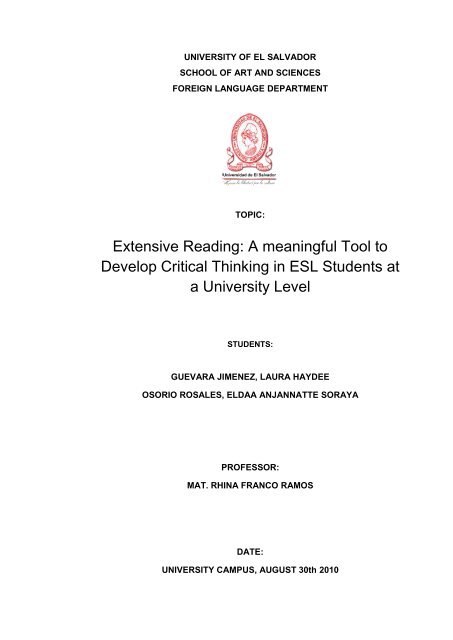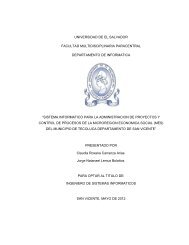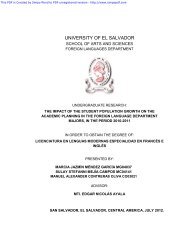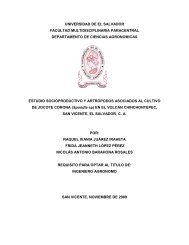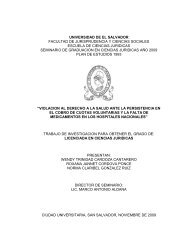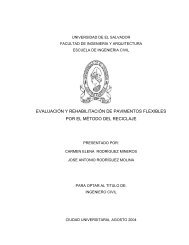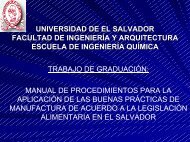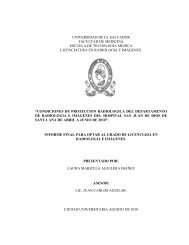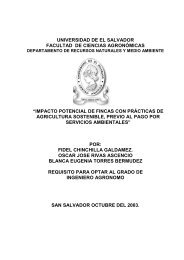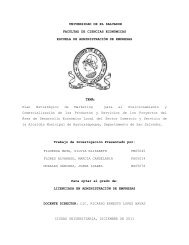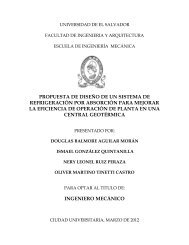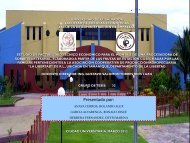Extensive Reading: A meaningful Tool to Develop Critical Thinking ...
Extensive Reading: A meaningful Tool to Develop Critical Thinking ...
Extensive Reading: A meaningful Tool to Develop Critical Thinking ...
Create successful ePaper yourself
Turn your PDF publications into a flip-book with our unique Google optimized e-Paper software.
UNIVERSITY OF EL SALVADORSCHOOL OF ART AND SCIENCESFOREIGN LANGUAGE DEPARTMENTTOPIC:<strong>Extensive</strong> <strong>Reading</strong>: A <strong>meaningful</strong> <strong>Tool</strong> <strong>to</strong><strong>Develop</strong> <strong>Critical</strong> <strong>Thinking</strong> in ESL Students ata University LevelSTUDENTS:GUEVARA JIMENEZ, LAURA HAYDEEOSORIO ROSALES, ELDAA ANJANNATTE SORAYAPROFESSOR:MAT. RHINA FRANCO RAMOSDATE:UNIVERSITY CAMPUS, AUGUST 30th 2010
UNIVESIDAD DE EL SALVADORFACULTAD DE CIENCIAS Y HUMANIDADESDEPARTAMENTO DE IDIOMAS EXTRANGEROS<strong>Extensive</strong> <strong>Reading</strong>: A <strong>meaningful</strong> <strong>Tool</strong> <strong>to</strong><strong>Develop</strong> <strong>Critical</strong> <strong>Thinking</strong> in ESL Students ata University LevelPRESENTADO POR:GUEVARA JIMENEZ, LAURA HAYDEEOSORIO ROSALES, ELDAA ANJANNATTE SORAYAPARA OPTAR AL TITULO DE:LICENCIATURA EN IDIOMA INGLES OPCION ENSEÑANZADOCENTE DIRECTOR:MAT. RHINA FRANCO RAMOSSAN SALVADOR, EL SALVADOR, CENTROAMERICA, AGOSTO DE 2010
AUTORIDADES DE LA UNIVERSIDAD DE EL SALVADORING. RUFINO ANTONIO QUEZADASANCHEZRECTORARQ. MIGUEL ANGEL PEREZ RAMOSVICERRECTOR ACADEMICOMTRO. OSCAR NOE NAVARRETE ROMEROVICERRECTOR ADMINISTRATIVOLIC. DOUGLAS VLADIMIR ALFARO CHAVEZSECRETARIO GENERALAUTORIDADES DE LA FACULTAD DE CIENCIAS Y HUMANIDADESLIC. JOSE RAYMUNDO CALDERON MORANDECANODR. CARLOS ROBERTO PAZ MANZANOVICEDECANOMTRO. JULIO CESAR GRANDE RIVERASECRETARIO DE LA FACULTADAUTORIDADES DE LA FACULTAD DE CIENCIAS Y HUMANIDADESMSc. EDGAR NICOLAS AYALAJEFE DE DEPARTAMENTOM.Ed. RICARDO GARAY SALINASCOORDINADOR GENERAL DE LOS PROCESOS DE GRADOMAT. RHINA FRANCO RAMOSDOCENTE DIRECTOR
ACKNOWLEDGEMENTSTo the powerful God for giving me life during these years that I have workedon this research paper <strong>to</strong> face all difficulties along this time. Because He gaveme life and the strength <strong>to</strong> continue although sometimes I felt weak, he alwayssupported me. When I am in trouble he takes out my foot from the hole.Also I want <strong>to</strong> thank my husband, Jaime Eduardo Ramos, who has been withhis unconditional love, patience and motivation <strong>to</strong> finish my career. Also he hasalways supported me whenever I needed. While I worked on this, what I cancall the biggest work that I have done in my life. This thesis is dedicated <strong>to</strong> mychildren Jaime André, Josué Eduardo and Emma Karolina Ramos Guevara,who have always s<strong>to</strong>od by me and dealt with all of my absence from manyfamily occasions with a smile.To my parents José Guevara and Bertha de Guevara for giving me thenecessary <strong>to</strong>ols that I have needed <strong>to</strong> develop my life. Now I just want <strong>to</strong> thankthem for their dedicated education, for their unconditional love and patienceand for everything I am. To my whole family, because they are very theimportant and they are always by my side.To my partner on this research Eldaa Anjannatte Soraya Osorio Rosales <strong>to</strong>whom I admire for her patience and all the ideas she gave for the creation andcompletion of our goals during this time. Also I want <strong>to</strong> thank her special familywho has been always unconditional and helped us a lot.LAURA HAYDEE GUEVARA JIMÉNEZ
ACKNOWLEDGEMENTSI am heartily thankful <strong>to</strong> God and Virgin of Fatima, whose encouragement,guidance and support from the initial <strong>to</strong> the final level enabled me <strong>to</strong> developan understanding of this research paper.I wish <strong>to</strong> thank, first and foremost, my mother Lila del Carmen RosalesRenderos. She bore me and raised me with all her love and patience. At thesame time she has always supported me, loved me, and taught me everything<strong>to</strong> begin and finish my career. Also I dedicate this thesis in memory of myfather Juan An<strong>to</strong>nio Osorio López, who always helped me and believed that Icould do it.I would like <strong>to</strong> thank my step-father Santiago Henriquez Arévalo. He is nowunder God’s presence but he supported me, loved me and spent a lot of timehelping me with everything he could. Besides I am grateful with my sisterClaudia Marielos, her husband Pedro Fuentes and my brother SantiagoGeovanny Henriquez Rosales. And my beloved nephew Ernes<strong>to</strong> Karol whogives me a lot of emotional support and caring love. I owe my deepestgratitude <strong>to</strong> my grandmother An<strong>to</strong>nia Renderos and my aunt Gloria Renderos.At the same time I offer my regards and blessings <strong>to</strong> all of my family whosupported me pray God for the completion of this research paper. I would like<strong>to</strong> show my gratitude <strong>to</strong> my dear friend Amy Diaz for all the emotional support,entertainment, and caring she provided.It is with immense gratitude that I acknowledge the support and help of myProfessor Rhina Franco Ramos. She provided encouragement, sound advice,good teaching, and lots of good ideas <strong>to</strong> make this research paper possible.I share the credit of my work with my partner Laura Haydée Guevara Jiménezfor her great contributions and patience <strong>to</strong> complete the research paper.SORAYA OSORIO ROSALES
TABLE OF CONTENTSI. Introduction……………………………………………………………………… iII. Objectives…………………………………………………………………………1II.1 General ObjectivesII.2 Specific ObjectivesIII. Justification……………………………………………………..……………….2IV. <strong>Extensive</strong> <strong>Reading</strong>: A Meaningful <strong>Tool</strong> <strong>to</strong> <strong>Develop</strong><strong>Critical</strong> <strong>Thinking</strong> in ESL Students at a University LevelIV.1 Introduction………………………………………………………….……4IV.2 <strong>Reading</strong> TechniqueIV.2.1 Scanning…………………………………………….………………5IV.2.2 Skimming……………………………………………………………5IV.3 <strong>Reading</strong> ApproachesIV.3.1 Intensive <strong>Reading</strong>………………………………………………...6IV.3.2 <strong>Extensive</strong> <strong>Reading</strong>………………………………………………..6IV.3.3 Roles of <strong>Extensive</strong> <strong>Reading</strong>……………………………………..7IV.3.4 Benefits of <strong>Extensive</strong> <strong>Reading</strong>…………………………………..8
IV.4 Definition of <strong>Critical</strong> <strong>Thinking</strong>IV.4.1 What is <strong>Critical</strong> <strong>Thinking</strong>? ………………………………………9IV.4.2 Benefits of <strong>Critical</strong> <strong>Thinking</strong>……………………………………10IV.4.3 Characteristics of <strong>Critical</strong> <strong>Thinking</strong>……………………………11IV.5 Academic Benefits of <strong>Extensive</strong> <strong>Reading</strong>and <strong>Critical</strong> <strong>Thinking</strong> for ESL students…………………………….13IV.6 Professional Benefits of <strong>Extensive</strong> <strong>Reading</strong>and <strong>Critical</strong> <strong>Thinking</strong> for ESL students………………………….…16IV.7 Academic Benefits of <strong>Extensive</strong> <strong>Reading</strong>and <strong>Critical</strong> <strong>Thinking</strong> for ESL students……………………………19IV.8 Conclusion………………………………………….………………....21V. Recommendations……………………………….…………………………23VI. Methodology…………………………………………….…………………..24VII. Bibliography…………………………………………….………………….27
I. INTRODUCTIONTeaching English as an International Language has emerged in response <strong>to</strong>the global spread of English and the subsequent changing needs of learners.So, ESL students at University level have the necessity of developing manyaspects in their studies that can help change their lives. A way <strong>to</strong> do this is bydeveloping their critical thinking. And a technique of developing this skill is<strong>Extensive</strong> <strong>Reading</strong>. <strong>Critical</strong> thinking can contribute <strong>to</strong> think about all thepossibilities <strong>to</strong> solve a problem, <strong>to</strong> consider different points of view and <strong>to</strong>identify people’s arguments as good contribution or conclusions on a specific<strong>to</strong>pic.The term ESL is used in the work because the literature found that supportsthe report makes reference <strong>to</strong> this type of students. This is a <strong>to</strong>ol mostly usedand applied in other countries, and there is evidence of it. This happensbecause even though when students get <strong>to</strong> a university level even they havetaken different subjects in which they are required <strong>to</strong> read. It is difficult for them<strong>to</strong> do that since they have not been developed that habit in those previousschool years of study. Also this <strong>to</strong>pic was focused on ESL students rather thanEFL students because there are many references available and there existcommunities which are using these <strong>to</strong>ols. While with EFL no reference isavailable at the university and in the country.The ESL term, as a primary setting <strong>to</strong> show the university that other countriesuse these <strong>to</strong>ols, which benefit students, <strong>to</strong> obtain better academic, professionaland personal development. So this paper is intended <strong>to</strong> motivate students andteachers <strong>to</strong> start investigating and applying <strong>Extensive</strong> <strong>Reading</strong> and <strong>Critical</strong><strong>Thinking</strong> in their lives; it is intended for them <strong>to</strong> present some advantages
these two skills can provide so that they can continue developing this habit forthe rest of their lives.<strong>Reading</strong> is a <strong>to</strong>ol <strong>to</strong> obtain information around the world. This ability providesthoughts that encourage students <strong>to</strong> think; and when people think they canshape their lives and they can choose how <strong>to</strong> live, act and make decisions.Students can also learn through this skill how <strong>to</strong> question and analyze theinformation supplied in various forms. These were the main reasons ofchoosing this <strong>to</strong>pic because they help us analyze how extensive reading helpsdevelop the critical thinking skill in ESL students at a University level.This research work is divided in several parts. The first one is the introductionwhich gives a general view of the development of this research paper. Thesecond part is the objectives. These objectives set the goals <strong>to</strong> reach while thisresearch is carried out. The third part includes the justification which statesthe reasons why this research is important and the ones who will be benefitedby. The fourth part is the body of the research paper. Here the importance ofextensive reading as a <strong>meaningful</strong> <strong>to</strong>ol <strong>to</strong> develop critical thinking skills isdeveloped. The fifth part is the conclusion of the research work. It summarizesthe principal points of the research paper. Then the sixth part describes therecommendations <strong>to</strong> take in<strong>to</strong> account for possible changes in the study ofEnglish. The seventh part is related <strong>to</strong> the methodology which explains brieflythe steps followed <strong>to</strong> carry out the work. As the last part of this research paperthere is the bibliography, which lists all the books, websites and articlesconsulted <strong>to</strong> support the arguments established for extensive reading andcritical thinking.
III. JUSTIFICATIONIn order <strong>to</strong> successfully learn English, ESL students not only need <strong>to</strong> acquirethe four macro skills of listening, speaking, reading and writing, but also need<strong>to</strong> develop critical analytical skills. Traditionally, the educational emphasis haspredominantly been on the acquisition of speaking and writing skills. Theimportance of reading and listening, and the development of critical skills, hasmost often not been emphasized in the context of ESL classes; however, theskill of reading needs <strong>to</strong> be given more attention <strong>to</strong> develop critical thinkingamong students at a university level. Distinguishing among four types ofreading, it can be said that ´'extensive reading' is one of the most beneficial,since it promotes the development of critical thinking. Its benefits for thedevelopment of critical thinking, will serve ESL students beyond the confines ofthe academic world.We consider extensive reading as a very important element at a universitylevel, the reason for arguing this is because, among other benefits, it helps <strong>to</strong>increase and expand students’ critical thinking skills. The type of thought beingwidened by the environment students are surrounded by can be academic,religious, political, technological, and social. Another relevant reason fordeveloping critical thinking is that the time we are living at this moment needsa society that can think critically. This can be achieved by expanding thefrontiers of better thoughts that make the population and the country grow asindividuals, capable of thinking by themselves following their own leadershipand not just going behind others ideas. This can be reached by having a betteracademic development.
Moreover, if students can practice extensive reading as an everyday activitythey will gain a broader culture. This is reflected in the way they speakbecause they have more vocabulary <strong>to</strong> express their own ideas and thoughts.It opens as well a bigger perspective for them <strong>to</strong> face life by identifying the kindof decisions <strong>to</strong> make. But the reading routine needs <strong>to</strong> be practice carefully <strong>to</strong>comprehend and apply what it is been unders<strong>to</strong>od. This avoids a closed mindthat will limit the opportunities of accepting others’ points of view without acritical mind. This work is important because it intends <strong>to</strong> awaken students’interest in extensive reading. Besides it is expected that through this pagesteachers can find some new ideas that can be used in their classroomsFinally some of the contributions that can be obtained through this work arebased on including extensive reading in every subject students are in, takelabora<strong>to</strong>ry sessions, conversation clubs and an extensive reading corner in thefaculty´s library. So ESL students are should be surrounded by this approacheverywhere they are <strong>to</strong> build their critical thinking skill. Another part of thepopulation that can be benefited by these contributions is teachers; becausethey can find another <strong>to</strong>ol <strong>to</strong> help their students develop critical thinking.Consequently this can motivate them <strong>to</strong> choose extensive reading as a way <strong>to</strong>contrast their everyday teaching. So students can be active human brains athome, at the university, at their workplace and with the society as consciouscitizens of the reality that surrounds them.
IV. <strong>Extensive</strong> <strong>Reading</strong>: A Meaningful <strong>Tool</strong> <strong>to</strong> <strong>Develop</strong><strong>Critical</strong> <strong>Thinking</strong> in ESL Students at a University Level1. IntroductionIn order <strong>to</strong> successfully learn English, ESL students not only need <strong>to</strong> acquirethe four macro skills of listening, speaking, reading and writing, but also need<strong>to</strong> develop critical analytical skills. Traditionally, the educational emphasis haspredominantly been on the acquisition of speaking and writing skills. Theimportance of reading and listening, and the development of critical skills, hasmost often not been emphasized in the context of ESL classes. In this essay,we will argue that the skill of reading needs <strong>to</strong> be given more attention.Distinguishing among four types of reading, we will furthermore emphasizethat ´'extensive reading' is most beneficial, since it promotes the developmen<strong>to</strong>f critical thinking.As it is known, reading has many benefits. It allows the reader <strong>to</strong> obtainanswers <strong>to</strong> specific questions. These questions may come from our daily liveswhich are experiences we need <strong>to</strong> explain ourselves. The reader finds themeaning of their origin and gets the possible answers for them. One morebenefit from reading is that it facilitates the acquisition of new vocabulary andthoughts. This means that the reader gets a book and finds a lot of new words.Not all these words the reader is going <strong>to</strong> look for a definition in a dictionaryinstead of he may infer or associate them <strong>to</strong> the context. So he makes afurther use of these words <strong>to</strong> communicate in different forms. An extra benefitit is that it instills different ways <strong>to</strong> state opinions, or simply obtain or knowother techniques <strong>to</strong> discuss any <strong>to</strong>pic that can refer <strong>to</strong> an academic issue,professional or personal one.
The author Roy Harris’s assertion in Rethinking Writing (2000) states that:“The message is not something given in advance or given at all but somethingcreated by interaction between writers and readers as participants in aparticular communicative situation.” This message indicates that writers havethe intention <strong>to</strong> communicate it and the readers <strong>to</strong> decode it. Consequentlythis specifies that a cognitive process is involved in producing andunderstanding the linguistic communication practice of a written message. Theimportance of developing this reading skill is <strong>to</strong> be able <strong>to</strong> generate logicalideas, <strong>to</strong> be informed in general and specific areas, <strong>to</strong> get specific andupdated knowledge <strong>to</strong> analyze and comprehend different reading materials. Itis necessary <strong>to</strong> apply the some reading techniques <strong>to</strong> minimize the complexityof reading: scanning, skimming, predicting, previewing, asking questions,taking notes, summarizing. Additionally it will be explained the approaches ofintensive reading and extensive reading.2. <strong>Reading</strong> Techniques2.1 ScanningAs said by Annette Lamb and Larry Johnson scanning is a technique oftenused when looking up a word in the telephone book or dictionary. The purposeof this technique is <strong>to</strong> search for key words or ideas. In most cases, the readerknows what he or she is looking for, so the reader concentrates on finding aparticular answer. This technique involves moving the eyes quickly down thepage seeking for specific words and phrases.2.2 SkimmingOn the word of Annette Lamb and Larry Johnson skimming is used <strong>to</strong> quicklyidentify the main ideas of a text. Skimming is done three <strong>to</strong> four times fasterthan normal reading. It allows the reader <strong>to</strong> quickly assess whether a specificarticle is relevant for the research. An example of this technique is reading thenewspaper.
3. <strong>Reading</strong> Approaches3.1 Intensive <strong>Reading</strong>Intensive <strong>Reading</strong> often refers <strong>to</strong> the careful reading of shorter, more difficultforeign language texts with the goal of complete and detailed understanding.Intensive reading is also associated with the teaching of reading in terms of itscomponent skills (Bamford, J., & Day, R.R.,1997).Texts are studied intensivelyin order <strong>to</strong> introduce and practice reading skills such as distinguishing the mainidea of a text from the detail, finding pronoun referents, or guessing themeaning of unknown words. Intensive reading involves learners reading indetail with specific learning aims and tasks. For example, intensive readingactivities include skimming a text for specific information <strong>to</strong> answer true orfalse statements or filling gaps in a summary. As well with intensive reading,scanning texts can be used <strong>to</strong> match headings <strong>to</strong> paragraphs, and scanningjumbled paragraphs <strong>to</strong> read them carefully by putting them in<strong>to</strong> the correc<strong>to</strong>rder.3.2 <strong>Extensive</strong> <strong>Reading</strong><strong>Extensive</strong> reading is, in contrast <strong>to</strong> intensive reading, generally associated withreading large amounts of text with the aim of getting an overall understandingof the reading materials. Readers are more concerned with the meaning of thetext than with the meaning of individual words or sentences or the finding ofspecific information. <strong>Extensive</strong> reading as an approach <strong>to</strong> teaching readingmay be thought of in terms of purpose or outcome: Beatrice Mikulecky (1990),for example, calls it pleasure reading.It can also be viewed as a teaching procedure, as when Stephen Krashen(1993) terms it free voluntary reading, or when teachers give students time forin-class Sustained Silent <strong>Reading</strong> (SSR) a period of 20 minutes, for example,
when students and teacher quietly and independently read self-selectedmaterial.3.3 Roles of <strong>Extensive</strong> <strong>Reading</strong>Krashen (1983) lists some of the roles extensive reading has in LanguageLearning. These roles can be achieved by doing an extensive reading routinethat gives the reader confidence <strong>to</strong> speak about many <strong>to</strong>pics <strong>to</strong> consolidateprevious knowledge. Also they facilitate new words <strong>to</strong> communicate effectivelyand express ideas, predictions, summaries and other ways <strong>to</strong> share theinformation about the text being read. Stephen Krashen mentions ten roles ofextensive reading <strong>to</strong> motivate readers <strong>to</strong> gain them in order <strong>to</strong> satisfy theirknowledge and necessities as ESL students. These are the roles by StephenKrashen of extensive reading:It can provide “comprehensible input”It can enhance learner general language competenceIt increases the students' exposure <strong>to</strong> the languageIt can increase knowledge of vocabularyIt can lead <strong>to</strong> improvement in writingIt can motivate learners <strong>to</strong> readIt can consolidate previously learned languageIt helps <strong>to</strong> build confidence with extended textsIt encourages the exploitation of textual redundancyIt facilitates the development of prediction skills
3.4 Benefits of <strong>Extensive</strong> <strong>Reading</strong>The following chart that Richard Day did in 2009 is a summary of the results ofdifferent studies done in ten countries. This chart indicates shows the benefitsof extensive reading on EFL and ESL learners.The chart emphasizes on an extract of the four most common benefits an ESLlearner obtains with extensive reading materials. The following benefitsextracted from the table are:Vocabulary growthImprovement in the other macros skillsGains in motivation and attitude so students become eager readers.Increasing reading rate.
4. Definition of <strong>Critical</strong> <strong>Thinking</strong>4.1 What is <strong>Critical</strong> thinking?Richard Paul states on his website called <strong>Critical</strong> <strong>Thinking</strong> Community adefinition of critical thinking which is the art of thinking about thinking in anintellectually disciplined manner because it is a process which involves a widerange of skills <strong>to</strong> be developed. <strong>Critical</strong> thinking involves following proofs,thinking about all the possibilities, relying upon reasons instead of feelings,considering different points of view, taking in<strong>to</strong> account the effects ofprejudices, and not refusing popular opinions. Consequently it entails beingable <strong>to</strong> identify other people’s arguments as well as their conclusions on aparticular <strong>to</strong>pic. This means critical thinking is an important skill ESL studentsneed <strong>to</strong> develop from extensive reading materials which are books of theirpleasure <strong>to</strong> become analytical and conscious people about the environmentthat surrounds them.Moreover an investigation done by Zaid Ali Alsagoff (2008) characterizescritical thinking as the intellectual disciplined process of actively and skillfullyconceptualizing, applying, analyzing, synthesizing, and /or evaluatinginformation gathered from, or generated by, observation, experience,reflection, reasoning, or communication, as a guide <strong>to</strong> belief and action. It is agreat <strong>to</strong>ol <strong>to</strong> develop critical thinking skills in order <strong>to</strong> create an interest infinding new solutions <strong>to</strong> different problems. Also a critical thinker develops anopen mind <strong>to</strong> participate in debates, forums, chat rooms. The reader has theconfidence on the information gathered on the extensive reading routine doneon a certain period of time.
4.2 Benefits of critical thinkingThere are many writers that list many benefits of critical thinking but for thispaper are considered these ones which are taken from Zaid Ali Alsagoff(2008). These could be of academic, professional or personal nature.ACADEMIC PERFORMANCEIncreases understanding of the arguments and beliefs of othersFosters a critical evaluation of those arguments and beliefsAllows for the development and defense of one´s own well-supportedarguments and beliefWORKPLACEHelps us <strong>to</strong> reflect and obtain a deeper understanding of our own andother´s decisions.Encourages us <strong>to</strong> obtain an open-mindedness for a changeAids us in being more analytical in solving problemsDAILY LIFEHelps us <strong>to</strong> avoid making rash personal decisions.Promotes an informed and concerned citizenry capable of making gooddecisions on important social, political and economic issues.Aids in the development of au<strong>to</strong>nomous thinkers capable of examiningtheir assumptions, dogmas, and prejudices.
4.3 Characteristics of critical thinkingC. Wade (1995) affirms a number of important characteristics of criticalthinking when he states that “[it] involves asking questions, defining a problem,examining evidence, analyzing assumptions and biases, avoiding emotionalreasoning, avoiding oversimplification, considering other interpretations, and<strong>to</strong>lerating ambiguity” (C. Wade 1995). In sum, critical thinking helps <strong>to</strong> developa critical mind and a broad theoretical framework of a variety of <strong>to</strong>pics. It alsohelps one <strong>to</strong> support one’s viewpoint with argumentative and well-foundedclaims.Jones & Ratcliff (1993) express that critical thinking has another relevantcharacteristic which is related <strong>to</strong> metacognition. Metacognition is thinkingabout one's own thinking. More specifically, "metacognition is being aware ofone's thinking as one performs specific tasks and then using this awareness <strong>to</strong>control what one is doing" Jones & Ratcliff, (1993), p. 10. For example, you mayuse a self-questioning strategy while reading as a means of obtainingknowledge (cognitive), or as a way of moni<strong>to</strong>ring what you have read(metacognitive). This means that metacognition is a self-control processwhich guides us <strong>to</strong> get our learning strategies. When you are doing extensivereading you are applying thinking about thinking and getting knowledge aboutknowledge with your own strategies.In addition, there are three aspects that critical thinkers develop. First, theylearn <strong>to</strong> ask good, logically-sound questions, by assessing the implications ofall implied premises Gerald Nosich (2005). <strong>Critical</strong> thinkers tend <strong>to</strong> focus theirattention on formulating assertive questions. By asking well-foundedquestions, the likelihood of obtaining reliable answers increases. Secondly,critical thinkers learn <strong>to</strong> use and comprehend language with accuracy, clarity,
and discrimination according <strong>to</strong> Edward Glaser (1942). A sound textualcomprehension consists of a full understanding of the various meaningsimplied in the materials being read. Last, critical thinkers have <strong>to</strong> reconstructtheir patterns of beliefs as the basis of wider experience, evaluating anargument in terms of reasonability and practicality. All these assertivedeclarations can be practiced by reading habits. It is vital <strong>to</strong> include the readingspeed and method according <strong>to</strong> the type of materials and the purpose ofreading.We argue that extensive reading develops critical thinking skills in ESLstudents at a university level considered necessary for academic, professionaland personal growth. According <strong>to</strong> Bamford and Helgesen (1998) extensivereading is a very effective way of reinforcing, confirming and deepeningknowledge of vocabulary, expressions and structures, and of developing animplicit understanding of when and how words are used. <strong>Critical</strong> thinking isthinking that helps establish well-founded judgments and utilizes appropriateevaluation standards in the attempt <strong>to</strong> determine the true worth, or value oftheir reading. If extensive reading is encouraged in English class, it willpromote critical thinking, which in its turn will instill a critical and reflexiveattitude in ESL students. As such, ESL students will be more likely <strong>to</strong> formwell-founded and fair judgments and beliefs in their academic endeavors, butalso in their future careers and personal lives.
5. Academic Benefits of <strong>Extensive</strong> <strong>Reading</strong> and <strong>Critical</strong><strong>Thinking</strong> for ESL studentsAs is indicated by the previous definitions, students at a university level need<strong>to</strong> have extensive reading as an important component of their academiccurriculum as this promotes a superior comprehensive level. The wayinformation is obtained when engaging in this reading method allows for amore critical mode of interacting with the reading materials. Whenimplementing this method, information is processed by analyzing it,questioning, making inferences and obtaining unique conclusions. As Zaid AliAlsagoff (2008) puts it, when one starts asking questions and seeking answersone is in fact thinking. When one reads material of personal interest and askswhy it has been written in that form, one’s brain is encouraged <strong>to</strong> look for theanswers for your own interrogations. <strong>Thinking</strong> critically, one is using one’sbrain <strong>to</strong> make sense of one’s own world. Because you are analyzing,evaluating and reasoning for problem solving and decision making.Students can develop academic arguments for any <strong>to</strong>pic that they encounter.For this purpose, they can use critical vocabulary, exploring their beliefs andargumentation, clarifying and questioning their work. Furthermore, in order <strong>to</strong>criticize a well-constructed argumentation, students must examine or evaluatethe assumptions they face in their argumentation. They need <strong>to</strong> be diligent inseeking relevant information, being able <strong>to</strong> read between the lines, analyzing,evaluating and inferring. Additionally, good critical thinkers can do two morethings: they can explain what they think and how they arrive at that judgment.A critical thinker is someone who has developed a knowledgeableunderstanding of the complexities inherent in the world, a thoughtfulperspective on important ideas and timely issues, the capacity for penetratinginsight and intelligent judgment, and the ability for sophisticated thinking and
language abilities John Chaffee (2006). <strong>Critical</strong> thinkers then can relate allthese characteristics mentioned above <strong>to</strong> improve their previous opinions.Richard Paul (2004) and Peter Facione (1998) state that ESL students developcritical thinking skills through extensive reading. According <strong>to</strong> their argument, itis important <strong>to</strong> use critical thinking criteria <strong>to</strong> obtain authentic active learningand academic success. Students apply course concepts in real life situations,having the opportunity <strong>to</strong> think independently, basing their judgments on whatthey have read. Within educational environments, both students and teachersengage in active learning when participating in extensive reading, since thismethod allows for critical analysis. The more students read the more theycome <strong>to</strong> understand the world.Students can be aware of the relationship between critical thinking andextensive reading, especially for academic studies which provide a context inwhich the two skill sets interrelate significantly. Students should know thatthey should not accept everything they read. They have <strong>to</strong> examine readingmaterials <strong>to</strong> obtain their own points of view and perspectives. Because humanbeings naturally create and build concepts through the information availableabout them, reading creates the unique opportunity <strong>to</strong> build academic successby thinking critically. Students need <strong>to</strong> think about the materials they read anduse their own conceptualizations.Scrutinizing new information by engaging in critical thinking, students becomeindependent thinkers and au<strong>to</strong>nomous learners, trying out new ideas andactively making sense of cognitive structures. To maximize the quality ofthinking, however, you must learn how <strong>to</strong> become an effective critic of your
own thinking. In order <strong>to</strong> achieve this, you have <strong>to</strong> make learning aboutthinking a priority Paul and Elder, (2001).ESL students develop a reflective mind when they engage in reflective thinkingof what they are reading. They can decide what information is important <strong>to</strong>face the issues that concern them. At the same time they will be more aware <strong>to</strong>collect opinions from trustworthy sources. A reader with a reflective mind hasthe following characteristics: (s)he is purposeful and adjusts the extensivereading <strong>to</strong> definite goals <strong>to</strong> achieve in order <strong>to</strong> be successful in the academicfield. Moreover, the reader has the ability <strong>to</strong> integrate ideas and information,which implies that (s)he joins the ideas obtained from the text <strong>to</strong> the ones (s)healready had. What is more, a reader with a reflective mind is critical in thesense that (s)he is looking for clarity, precision, relevance, logic significanceand fairness. And a last characteristic is for the reader <strong>to</strong> be open <strong>to</strong> newperspectives in order <strong>to</strong> acquire the knowledge <strong>to</strong> be an active citizen in thiscomplex world.Students will be able <strong>to</strong> agree or disagree with the texts they have read inorder <strong>to</strong> express their points of view. Subsequently, teachers will have moreopportunity for group and class discussions, debates, forums, and interviews.What is more, these activities will be facilitated by the fact that students willmost likely be more inclined <strong>to</strong> participate actively, since they are more likely <strong>to</strong>feel comfortable <strong>to</strong> express and criticize the situations they encounter whilereading <strong>to</strong> contexts pertaining <strong>to</strong> their everyday lives. Moreover, students areless likely <strong>to</strong> feel the pressure of having <strong>to</strong> answer questions, since the latterwill only be asked at the end of each section and since no dictionary isrequired. Students are more likely <strong>to</strong> aware of their own choices when they areengaging a pleasurable activity, and, as was cited earlier, extensive reading isoften considered pleasurable. The rewards students will obtain will be of
academic, professional and personal nature and as such they will obtain moregrowing opportunities in their country.<strong>Critical</strong> thinking is thinking that explicitly aims <strong>to</strong> establish well-foundedjudgments and utilizes appropriate evaluation standards <strong>to</strong> determine the trueworth, or value of what we have read. We can also describe it is asreasonable, reflective, responsible and skillful thinking that is focused ondeciding what <strong>to</strong> believe or <strong>to</strong> do in life. Someone who applies critical thinkingskills in his or her life is engaging in an analytical and profound study, becausethis person is concerned about the results obtained from analysis. According <strong>to</strong>Vic<strong>to</strong>r Maiorana (1992), the purpose of critical thinking is <strong>to</strong> understand thesituation <strong>to</strong> evaluate different points of view and <strong>to</strong> solve problems. Also,Barbara Fowler (2002) affirmed that critical thinking is connected withrationality, liberalism and clarity of mind while it is contrary <strong>to</strong> mental inactivityand insularity. <strong>Critical</strong> thinking means <strong>to</strong> think open-mindedly with your feet onthe ground <strong>to</strong> make assertive and objective decisions.6. Professional Benefits of <strong>Extensive</strong> <strong>Reading</strong> and <strong>Critical</strong><strong>Thinking</strong> for ESL studentsESL students at a university level should apply extensive reading <strong>to</strong> expandand increase their critical thinking talents. The latter will be gained whenstudents develop their reading abilities beyond the classroom. Students willbecome good critical thinkers within their jobs by contributing <strong>to</strong> thedevelopment of the companies they work for. In addition ESL students will lookbeyond their jobs and communities <strong>to</strong> have a say in defining a set of criteria <strong>to</strong>analyze ideas and find new solutions <strong>to</strong> particular problems. Also they cansupport beliefs and change opinions with new facts they found while doing
extensive reading. At the same time the employee who reads for pleasure is agood candidate <strong>to</strong> be the company advisor’s based on the critical thinkingability that this person shows <strong>to</strong> company’s manager.Becoming good readers of English is helpful <strong>to</strong> keep active critical thinkingskills, which in turn will help gain benefits in the professional sphere. In thismultifaceted world graduates who can adapt quickly <strong>to</strong> new changes improvetheir chances <strong>to</strong> obtain, retain and succeed in any job, and particularly in jobsthat require English fluency. The ability of critical thinking developed instudents of English through extensive reading is beneficial for theirprofessional careers since it improves their ability <strong>to</strong> make objective decisions,which helps the company they work for <strong>to</strong> maintain a better position in themarket, despite obstacles or difficulties. Graduates formulate objectivedecisions based on a careful evaluation <strong>to</strong> produce the best and moreaccurate solutions <strong>to</strong> problems. To face problems they need <strong>to</strong> haveacquainted all the information about different aspects of their work. So, theirability <strong>to</strong> engage in extensive reading, acquired in ESL class, will help them <strong>to</strong>find the right solution.What is more, <strong>to</strong> face problems these decisions have <strong>to</strong> be based on solidinformation and reasoned hypotheses. They need <strong>to</strong> impact the listener <strong>to</strong>avoid emotional manipulation, deceiving reasoning and lazy thinking. Usingtheir critical thinking criteria, analysis and judgment, graduates can use theircognitive development Lev Vigotsky (1978). In this sense, critical thinking skillshelp graduates climb the ladder of corporate success. A person whosethoughts and solutions are assertive is known as a person that can fit in newpositions, because of his ability <strong>to</strong> think critically. The path <strong>to</strong> obtain, retainand succeed in the job is not without pitfalls but in the end the results are likely<strong>to</strong> be very positive.
Also, graduates who can think critically and communicate effectively are easilypromoted <strong>to</strong> a higher position in their workplaces. This opportunity of beingpromoted gives them the chance <strong>to</strong> put in<strong>to</strong> action their proficiency skills <strong>to</strong>deal with a costumer and with internal difficulties in the company.Consequently, they must apply critical skills <strong>to</strong> obtain satisfac<strong>to</strong>ry results whendealing with a purchaser’s issue, so that they cover their expectations. Theyneed <strong>to</strong> display confidence <strong>to</strong> the person they are talking <strong>to</strong>. To facilitate aneffective communication it is necessary <strong>to</strong> engage in direct and transparentcommunication and <strong>to</strong> use visual images <strong>to</strong> help people understand what isbeing said. Indeed, it is necessary <strong>to</strong> keep active critical skills <strong>to</strong> learn <strong>to</strong> addmore value <strong>to</strong> the promotion with a plan <strong>to</strong> acquire them.It is essential <strong>to</strong> demonstrate critical thinking when talking <strong>to</strong> the supervisorand the colleagues. It is necessary <strong>to</strong> be clear in the formulation of ideas,positions, arguments, and analysis <strong>to</strong> send an exact message whennecessary. Rather than <strong>to</strong> accept things the way they are, it is necessary <strong>to</strong>think how <strong>to</strong> improve them and how <strong>to</strong> come up with innovative solutions <strong>to</strong>perform those things much better, how <strong>to</strong> create a good environment around,<strong>to</strong> obtain promotions position in their workplaces.Graduates who apply their critical thinking skills implement the idea underlyingcritical thinking, namely that the reader (re)constructs the text’s informationbased in part on the knowledge drawn from the text and in part from thereader’s prior knowledge. <strong>Critical</strong> thinking skills and the extensive reading habitcreate a environment of commitment in their workplace. This helps the peoplerealize that their voice is heard and that they are allowed <strong>to</strong> speak more. Theywill also build up a sense of ownership and pride in what they do and will takea great pleasure in their workmanship. It has a positive effect on the otherstaff’s attitude, <strong>to</strong>o. It generates an inclusive environment in which everyone is
valued for their distinctive contributions. Because of their skills and talents,graduates can gain respect among colleagues. They are motivated <strong>to</strong> growand develop their interests and skills in ways that both give personalsatisfaction and match with the needs of the business. The main goal inherentin the creation of a work place characterized by commitment is <strong>to</strong> construct apositive and respectful workplace where everyone feels proud of their work.The work place will not only be an environment in which workers take gooddecisions, and offer assertive analysis, but it will also be a setting free of anytension and discrimination.7. Personal Benefits of <strong>Extensive</strong> <strong>Reading</strong> and <strong>Critical</strong><strong>Thinking</strong> for ESL studentsESL students are going <strong>to</strong> analyze and assess the information that they gatherfrom reading extensively because it brings benefits <strong>to</strong> them. By thinkingcritically, these students are less likely <strong>to</strong> be emotionally involved in what theyare reading. They can view reading materials in a more scientific style and canthink logically instead. They will turn in<strong>to</strong> more observant people as well. Thistakes place because written thoughts give students the opportunities <strong>to</strong> thinkthrough arguments and make use of their high-order thinking skills <strong>to</strong> react andanswer <strong>to</strong> difficult problems. So extensive reading and written thoughts are tied<strong>to</strong> one another because they build up a reflective mind by analyzing andassessing all the information collected from the text.ESL students will develop their critical thinking skills by reading extensively, sothey avoid making foolish personal decisions in their life. Besides they are lesslikely <strong>to</strong> express an opinion on a <strong>to</strong>pic they have never read about before. As aresult, students are less inclined <strong>to</strong> judge people’s points of view withou<strong>to</strong>ffering solid arguments. It is particularly important <strong>to</strong> postpone judgment when
speaking another language, including English, since the foreign cus<strong>to</strong>ms andculture need <strong>to</strong> be taken in<strong>to</strong> account before offering any judgments. Peoplewho maintain the cus<strong>to</strong>m <strong>to</strong> read extensively continue on a high level ofjudgment since their mode of reading will adjust <strong>to</strong> their mode of thinking andnot vice versa. In everyday life an endless sequence of decisions has <strong>to</strong> betaken. Whereas some might be relatively inconsequential, others are large andlife-determining. So decision-making needs <strong>to</strong> be rational and coherent. Thesecharacteristics will maximize life quality and opportunities of pleasant living.Thus <strong>Critical</strong> thinking increases the level of consciousness and deliberatechoices.ESL students will become individuals who are informed and concerned citizensof their own growth who think critically independent in order <strong>to</strong> make assertivecontributions <strong>to</strong> the society. Society needs this kind of people, critical thinkers.<strong>Develop</strong>ing these two important components ESL students are able <strong>to</strong> setgoals that are reachable because they have obtained a more ample andknowledgeable understanding of this complex world. John Chaffee (2006)argues that a critical thinker is someone who has a thoughtful perspective onimportant ideas and timely issues, the capacity for penetrating insight andintelligent judgment, and sophisticated thinking and language abilities. Not allpeople can reach this kind of judgment. Another important element is <strong>to</strong> haveself-confidence in one’s own abilities <strong>to</strong> reason when making decisions. Also, itis necessary <strong>to</strong> have the ability <strong>to</strong> distinguish relevant from irrelevant choicesand <strong>to</strong> be aware of how these choices will affect life.As Zaid Ali Alsagoff (2008) through extensive reading and critical thinkingstudents judge, analyze and evaluate political, economic and social problems<strong>to</strong> avoid being only a consumer of society’s distractions. While practicingextensive reading they will obtain information about political, social and
economic problems the other countries and people have had. They will usetheir critical thinking skills <strong>to</strong> make judgments about those situations andconnect them <strong>to</strong> the present time. So this will create a guide for makingintelligent decisions in order <strong>to</strong> have a better quality of life. Also they willanalyze and evaluate how <strong>to</strong> formulate rational choices <strong>to</strong> gain personalliberation and improvement so that they are not only the shadow or theconsumer of someone or something else. A vital point <strong>to</strong> mention is that allthis is done by using their thinking skills in an ethical manner. Moreover, ESLstudents, as conscientious citizens, use reasoning elements <strong>to</strong> accomplishsome purpose, use concepts or ideas obtained from their extensive readinghabit and unique experiences. Using extensive reading, they use reliableinformation <strong>to</strong> draw logical conclusions, when dealing with societal or politicalissues.8. ConclusionESL students at a university level apply extensive reading, which helpsdevelop critical thinking skills, which, in turn, facilitate academic, professionaland personal benefits. When becoming well-versed in the skills of extensivereading and critical thinking, students are able <strong>to</strong> connect the knowledge theyobtain while reading <strong>to</strong> real life difficulties and <strong>to</strong> find logical attitudes <strong>to</strong> dealwith the latter. On the other hand, students are encouraged <strong>to</strong> become lifelongreaders of English <strong>to</strong> keep active their critical thinking skills. Students whohave an advanced aptitude in extensive reading and critical thinking will morelikely be open-minded <strong>to</strong>wards new ideas and perspectives, which foster acontinued intellectual and professional growth. They do not take a simplisticview of their work environment. They look for better job opportunities <strong>to</strong> havea different quality of life.
Moreover, students will develop their critical thinking skills <strong>to</strong> avoid makingirrational personal decisions in their lives. People who develop their criticalthinking skills jump over the barrier of self-commodity and passive status. Theyevaluate and consider new viewpoints or perspectives <strong>to</strong> solve problems or <strong>to</strong>make changes that benefit themselves and their surroundings. People whoknow how <strong>to</strong> obtain success in life do not stay in one place; they move throughbetter positions, opportunities, decisions, and so on so as not <strong>to</strong> fail in big lifedecisions. These decisions rely on knowledge acquired in day-<strong>to</strong>-dayextensive reading of texts that can help in life.<strong>Extensive</strong> reading really widens people’s critical thinking skills <strong>to</strong> make themactive human beings in the world, so that they are not like robots whose lifeand thoughts are controlled by others. When they realize that they are free andhave freedom <strong>to</strong> think, a new person is born with an open-mind <strong>to</strong> drawobjective and warranted conclusions. If these two elements of extensivereading and critical thinking are implemented in education they will createintellectual and disciplined people with an interest in new and innovatingperspectives. Finally, on our own experience with this <strong>to</strong>pic our life has beenenriched with relevant information that has made us aware of the way we viewour surroundings. We realize that it is important <strong>to</strong> maintain our extensivereading habit because the decisions we make now are done more rationally aswe are more conscious of the importance of the results we will obtain. If we donot read and further develop our critical faculties, we will lose manyopportunities of life development.
V. RECOMMENDATIONS1. To create an <strong>Extensive</strong> <strong>Reading</strong> club that includes a variety of <strong>Reading</strong>categories that covers the majority of necessities so the actualconversation clubs are kept <strong>to</strong> motivate students share their readingexperience with other students and teachers with discussions anddebates.2. To make a multilevel extensive reading program done by students fromthe social service department where students are divided in elementary,intermediate or advanced levels <strong>to</strong> participate in extensive readingactivities.3. To make a better use of the labora<strong>to</strong>ry by having books on CD´s, sostudents can listen and read them at the same time. This gives moreexcitement <strong>to</strong> read by pleasure.4. To motivate teachers that have <strong>Reading</strong> and Conversation classes usethe reading approach of extensive reading that is more beneficial in thesense that provides free reading activities than intensive reading, whichare controlled reading activities.5. To obtain updated books which can be used as research reference ofthe different subjects taken at this Department, so the EnglishDepartment Library and post on a white board the two books for theweek and this reduces the use of the web resources.6. To create a data base of online books where students can access by afacebook account from the English Department Library <strong>to</strong> select thebooks they want <strong>to</strong> read. This project can be carried out by the socialservice department students.
VI. METHODOLOGYThe first step was selecting a <strong>to</strong>pic. The <strong>to</strong>pic selected <strong>Extensive</strong> <strong>Reading</strong> aMeaningful <strong>Tool</strong> <strong>to</strong> <strong>Develop</strong> <strong>Critical</strong> <strong>Thinking</strong> Skills in ESL students waschosen because of the benefits it can bring not only <strong>to</strong> university students butalso teachers. The academic field of this subject is ESL students at auniversity level with three types of advantages the academic, professional andpersonal ones. So the selection of this <strong>to</strong>pic was that extensive reading andcritical thinking both are the main components a person needs <strong>to</strong> get adifferent point of life.The second step was searching the literature before this step with discuss the<strong>to</strong>pic <strong>to</strong>gether with our men<strong>to</strong>r <strong>to</strong> have a clear picture of what the researchwould be about. After having much clearer the <strong>to</strong>pic we look for literaturereferring <strong>to</strong> extensive reading and critical thinking. The support <strong>to</strong> the <strong>to</strong>pic withreliable information comes from well-known researches like Harmer in his book“The practice of English Language Teaching. Another author consulted wasPatricia Carrel with her book English for specific purposes <strong>Extensive</strong> andIntensive reading in an EAP setting, and we prepared cards <strong>to</strong> keep track ofauthors consulted. All of these reading selections above guided us <strong>to</strong> have ascaffolding <strong>to</strong> relate extensive reading with critical thinking and <strong>to</strong> develop ourarguments. During this step, we applied some reading techniques suchskimming, scanning <strong>to</strong> select the material <strong>to</strong> be used.The third step was developing the argument before starting writing the essay,we investigated the meaning of some terminology and other aspects related <strong>to</strong>the work <strong>to</strong> be presented. Then we started the work by preparing an outlineand doing some free writing based on ideas gotten from authors consulted and
personal experience. The argument was created by giving an opinion thatextensive reading develops the critical thinking skill of ESL students. It issupported with three reasons which established that ESL students openthemselves <strong>to</strong> obtain three types of benefits which are academic, professionaland personal ones. Each reason is sustained with bibliographical referenceand personal experiences.The fourth step was surveying the literature. There are two types of argument:complex and simple. The type of argument that we have chosen is simple.Because the thesis statement has the argument position followed by threesupporting ideas which are claims with reasons. They have evidence <strong>to</strong> clearlymark the author’s ideas. First the literature was explored <strong>to</strong> have the rightrelation with our thesis statement. At the beginning we did not find resourcesthat connected the two purposes which are extensive reading and criticalthinking. We did not find books with the two <strong>to</strong>pics already joined. So for thisreason the next step we <strong>to</strong>ok <strong>to</strong> obtain evidence from each part was <strong>to</strong>investigate them separately.We got important information <strong>to</strong> justify our point <strong>to</strong> argue that extensivereading is a <strong>to</strong>ol that develops critical thinking skills in ESL students at aUniversity level. This was done by consulting books that we download from theinternet. We read essays written by students from other universities, fromdifferent countries, and they gave us support <strong>to</strong> our thesis statement. Thenanother resource consulted were different websites that have updatedinformation from both parts of the <strong>to</strong>pic. They are listed in the bibliographysection. Then we structured the claims with their reasons for each <strong>to</strong>pic <strong>to</strong> formthe paragraphs of our research work.
The fifth step was critiquing the literature. At this step we started organizing theideas <strong>to</strong> write our first draft and then a second draft which included all theinformation gotten from the sources consulted which is in respond <strong>to</strong> theargument given by us and the authors’ proofs supply justification <strong>to</strong> theresearch work.The final step was writing the review, during this step we wrote our final draftwhich is the result of the different steps carried out along this bibliographicalresearch. It is important <strong>to</strong> mention that this was not a lineal process; it was acyclical one; meaning this, that we occasionally revised previous steps <strong>to</strong>improve them and <strong>to</strong> write the final product.
VII. BIBLIOGRAPHYBOOKSBamford, J., & Day, R.R. (1997). <strong>Extensive</strong> <strong>Reading</strong>: What is it? WhyBother? The Language Teacher, University of Hawaii, Cambridge:Cambridge University Press. Cites: Beatrice Mikuleky(1990).Krashen, S. (1993) The Power of reading, Englewood, CO: LibrariesUnlimited.Maiorana, Vic<strong>to</strong>r P., 1992. <strong>Critical</strong> <strong>Thinking</strong> across the Curriculum:Building the Analytical Classroom. Booming<strong>to</strong>n, Indiana.Paul, R & Elder, L. (2008) The Miniature Guide <strong>to</strong> <strong>Critical</strong> <strong>Thinking</strong>:Concepts and <strong>Tool</strong>s, Foundation for <strong>Critical</strong> <strong>Thinking</strong>, Dillon Beach,CA, USAWEBSITESLamb, Annette, Johnson, Larry. January, 1999. Updated, April 2001.Scanning and Skimming Definitions.OnlineAvailable: http://42explore.com/skim.htmPaul, Richard. (2004). The state of critical thinking <strong>to</strong>day: TheNeed for a substantive concept of critical thinking. RetrievedFeb. 27, 2006, fromOnlineAvailable:http://www.criticalthinking.org/resources/articles/the-state-ct-<strong>to</strong>day.shtmlThe <strong>Critical</strong> <strong>Thinking</strong> Community, Dillon Beach, CA.Cites: Paul and Elder, 2001. Gerald Nosich, 2005. Edward Glaser,1942.Richard Paul, 2004. Peter Facione, 1998. <strong>Critical</strong> <strong>Thinking</strong> definitions.OnlineAvailable: http://www.criticalthinking.org/
Surry Community College <strong>Critical</strong> <strong>Thinking</strong>, Dobson, NorthCarolina. Cites: John Chaffee, 2006.OnlineAvailable: http://www.surry.edu/about/ct/why_ct.htmlHandout from the <strong>Extensive</strong> <strong>Reading</strong> Forum, Omiya, JapanSunday, November 22, 1998.OnlineAvailable: http://www.extensivereading.net/er/JALT98.html<strong>Extensive</strong> <strong>Reading</strong> and its role in Japanese High Schools.OnlineAvailable: http://www.readingmatrix.com/articles/powell/article.pdfThe Language Learning Benefits of <strong>Extensive</strong> <strong>Reading</strong>, Paul Nation,Vic<strong>to</strong>ria University of Welling<strong>to</strong>nOnlineAvailable: http://jalt-publications.org/tlt/files/97/may/benefits.htmlARTICLESAlsagoff, Zaid Ali. Introduction <strong>to</strong> <strong>Critical</strong> <strong>Thinking</strong>, 2003.OnlineAvailable:http://www.slideshare.net/zaid/introduction-<strong>to</strong>-critical-thinkingBell, Timothy, <strong>Extensive</strong> <strong>Reading</strong>: Why? and How?, The Internet TESLJournal, Vol. IV, No. 12, December 1998. Cites Stephen Krashen, 1983.OnlineAvailable: http://iteslj.org/Articles/Bell-<strong>Reading</strong>.html
Chandra Dugar, Dr. Pari<strong>to</strong>sh,2009. The Role of <strong>Critical</strong> and Creative<strong>Thinking</strong> in TESL Context, Vice-Principal, SMB Govt. P.G. College,Nathdwara(Rajasthan). Cites C. Wade 1995.OnlineAvailable:http://www.eltweekly.com/elt-newsletter/2010/06/60-research-...Powell, Steve. 2005. The <strong>Reading</strong> Matrix, Vol 5, No. 2, <strong>Extensive</strong><strong>Reading</strong> and its Role in Japanese High Schools, Japan, Hiroshima.Cites: Harold Palmer, 1968 and Bamford and Helgesen. 1998.Adsit, Karen I. Teaching <strong>Critical</strong> <strong>Thinking</strong> Skills, 2007. Last Updated:Thursday, March 22, 2007. Cites Jones and Ratcliff 1993.OnlineAvailablehttp://academic.uday<strong>to</strong>n.edu/legaled/ctskills/ctskills01.htmBilgin, A., Eldeleklioglu, J. from H.U. journal of Education, 2007 pages55-67. Cites: Fowler 2002 who is cited by Kurland and DanielOnlineAvailablehttp://www.efdergi.hacettepe.edu.tr/200733ASUDE%20B%C4%B0LG%C4%B0N.pdfBenson, Professor Clare. , University of Central England, Faculty ofEducation cites: Vigotsky, 1978. Mind in society. Cambridge, HarvardUniversity PressOnlineAvailablehttp://www.unesco.org/education/educprog/ste/pdf_files/connect/ClareBenson.PDF


